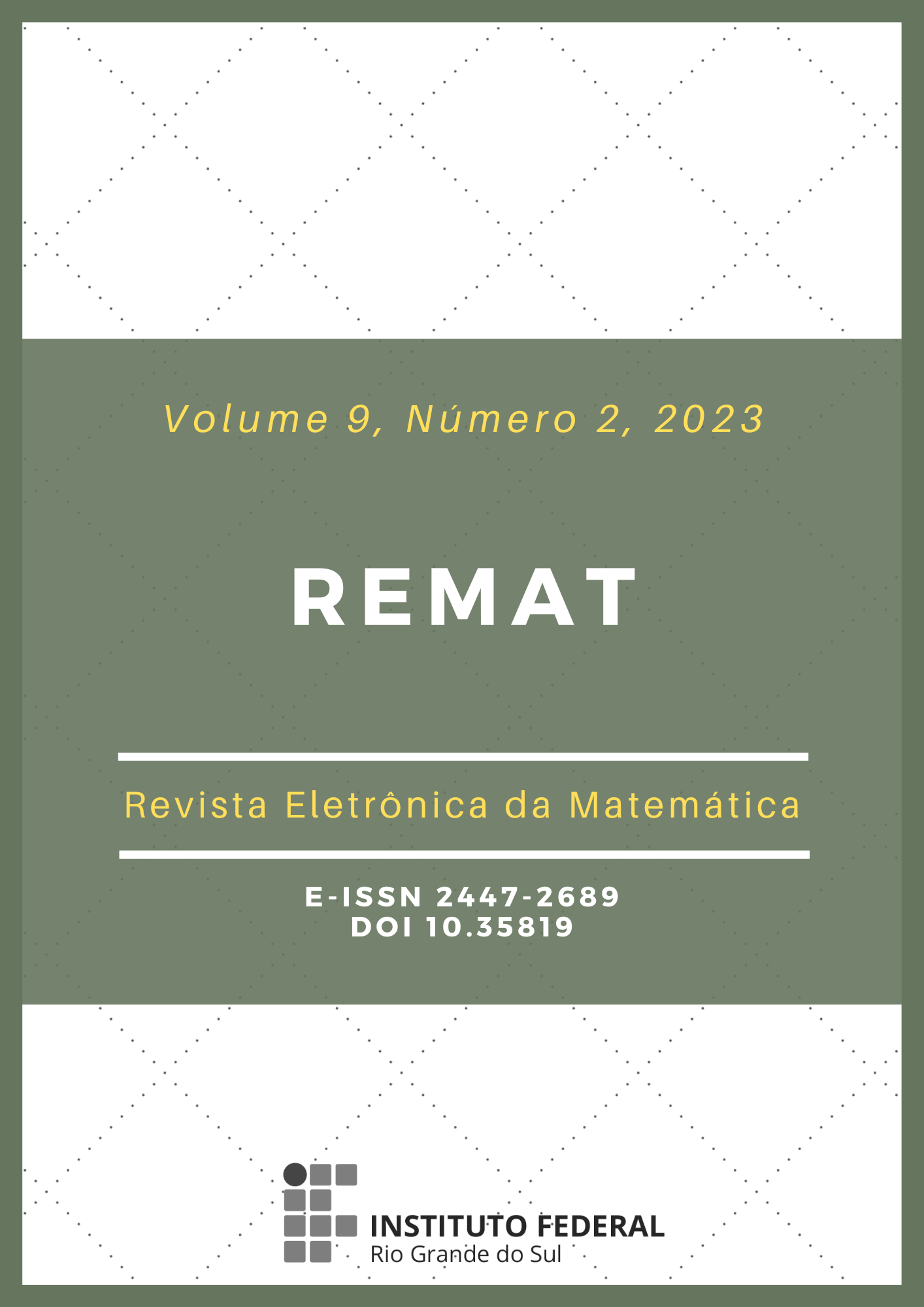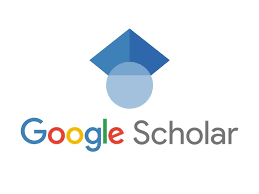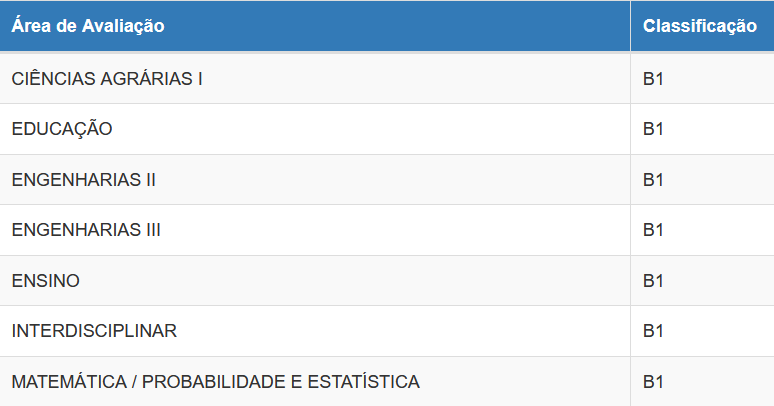Mobile Learning and Active Methodologies in Teaching Complex Numbers in Vocational and Technological Education
DOI:
https://doi.org/10.35819/remat2023v9i2id6305Keywords:
Mathematics Teaching, Active Methodologies, Mobile Learning, Complex Numbers, Teaching ProjectAbstract
This article presents an account of the research and pedagogical practice of a teacher trainer and a teacher in initial training in the teaching project “Complex Numbers: Microlearning for meaningful learning”. The project involved seventeen students from the 3rd year of the Technical Course in Integrated High School Electro-technical of the Federal Institute of Education, Science, and Technology of Tocantins and it was carried out from October to December 2021. This study consists in answering the following question: How do students at Integrated Technical High School mobilize meaningful learning about Complex Numbers when using mobile learning through active methodologies? This study aims to understand the learning of young students using mobile devices involving the theme of Complex Numbers, through the use of active methodologies. This is a qualitative, analytical-descriptive study, which highlights the use of educational technology tools to provide learning in Mathematics through games, apps, and virtual platforms. The results of this study are: the use of apps was a method that allowed the dynamic visualization of mathematical procedures, and mobile learning and active methodologies reflect the need for the student to become the protagonist of his learning. It is concluded that, in addition to comprehensive training and human emancipation of the student, the pedagogical proposal enabled a theoretical and practical process from a collaborative perspective regarding the teaching of mathematics in Vocational and Technological Education.
Downloads
References
ANDRADE, R. S. de. O uso de aplicativos móveis para o ensino e aprendizagem de matemática em turmas do ensino médio e superior de matemática. Revista Projeção e Docência, v. 10, n. 2, p. 31-41, 2019. Disponível em:
http://revista.faculdadeprojecao.edu.br/index.php/Projecao3/article/view/1406. Acesso em: 5 ago. 2022.
BACICH, L.; MORAN, J. Metodologias ativas para uma educação inovadora: uma abordagem teórico-prática. Porto Alegre: Penso, 2018.
BENDER, W. N. Aprendizagem baseada em projetos: educação diferenciada para o século XXI. Porto Alegre: Penso, 2014.
BORBA, M. C.; ASKAR, P.; ENGELBRECHT, J.; GADANIDIS, G.; LLINARES, S.; AGUILAR, M. S. Blended learning, e-learning and mobile learning in mathematics education. ZDM Mathematics Education, v. 48, n. 5, p. 589-610, jun. 2016. DOI: https://doi.org/10.1007/s11858-016-0798-4.
BRASIL. Ministério da Educação. Instituto Nacional de Estudos e Pesquisas Educacionais Anísio Teixeira. Matriz de Referência para o ENEM 2020. Brasília: INEP/MEC, [2020]. Disponível em: https://download.inep.gov.br/download/enem/matriz_referencia.pdf. Acesso em: 30 jul. 2022.
BRASIL. Ministério da Educação. Secretaria da Educação Básica. Base Nacional Comum Curricular. Brasília, 2018. Disponível em: http://basenacionalcomum.mec.gov.br/images/BNCC_EI_EF_110518_versaofinal_site.pdf. Acesso em: 20 jul. 2022.
BUCHEM, I.; HAMELMANN, H. Microlearning: a strategy for ongoing professional development. eLearning Papers, n. 21, p. 1-15, set. 2010.
CARNEIRO, Jaíne. O uso do Kahoot! e do Ensino Híbrido como ferramentas de ensino e da aprendizagem em Matemática. 102 fl. 2020. Orientadora: Scheila Valechenski Biehl. Dissertação (Mestrado Profissional em Matemática em Rede Nacional) - Universidade Estadual de Ponta Grossa, Ponta Grossa, 2020. Disponível em: http://tede2.uepg.br/jspui/handle/prefix/3257. Acesso em: 25 jul. 2023.
CARVALHO, D. L. Metodologia do Ensino da Matemática. São Paulo: Cortez, 2011.
DANTE, L. R. Matemática: Contexto & Aplicações. v. 3. 3. ed. São Paulo: Ática, 2016.
DIESEL, A.; BALDEZ, A.L.S.; MARTINS, N. Os princípios das metodologias ativas de ensino: uma abordagem teórica. Revista Thema, v. 14, n. 1. p. 268-288, 2017. DOI: https://doi.org/10.15536/thema.14.2017.268-288.404.
DUVAL, R. Registros de representações semióticas e funcionamento cognitivo da compreensão em Matemática. In: MACHADO, S. D. A. (org.). Aprendizagem em Matemática: registros de representação semiótica. 2. ed. Campinas, São Paulo: Papirus, 2003, p. 11-33.
FELTES, C. M.; PUHL, C. S. Estudo dos Prismas: compreendendo por meio de modelos matemáticos. Scientia cum Industria, v. 5, n. 3, p. 151-155, 2017. DOI: http://dx.doi.org/10.18226/23185279.v5iss3p151.
FIGUEIREDO, M. J. G.; GODEJORD, B.; RODRIGUES, J. I. R.; GONZÁLEZ-PÉREZ, A. MILAGE APP: Mobile Learning of Mathematics. In: EDULEARN 16 Proceedings, 8th International Conference on Education and New Learning Technologies, Barcelona, 4-6 jul. 2016, p. 8863-8872. DOI: http://dx.doi.org/10.21125/edulearn.2016.0937.
JOMAH, O.; MASOUD, A. K.; KISHORE, X. P.; AURELIA, S. Micro Learning: A Modernized Education System. BRAIN: Broad Research in Artificial Intelligence and Neuroscience, v. 7, n. 1, p. 103-110, 14 mar. 2016. Disponível em: https://lumenpublishing.com/journals/index.php/brain/article/view/1986. Acesso em: 23 out. 2022.
MAGALHÃES, W. de A. M.; PEREIRA, A. L. S. O uso da aprendizagem baseada em problemas no ensino técnico: projetos integradores como experiência interdisciplinar. Educitec: Revista de Estudos e Pesquisas sobre Ensino Tecnológico, Manaus, v. 5, n. 12, 2019. DOI: https://doi.org/10.31417/educitec.v5i12.836.
MORÁN, J. M. Mudando a educação com metodologias ativas. In: SOUZA, C. A. de; MORALES, O. E. T. (org.). Convergências Midiáticas, Educação e Cidadania: aproximações jovens, v. 2, Coleção Mídias Contemporâneas. Ponta Grossa: Foca Foto, PROEX/UEPG, 2015.
MOREIRA, M. A. Teorias de aprendizagem. 2. ed. São Paulo: EPU, 2011.
MUSSI, R. F. F.; MUSSI, L. M. P. T.; ASSUNÇÃO, E. T. C.; NUNES, C. T. Pesquisa Quantitativa e/ou qualitativa: distanciamentos, aproximações e possibilidades. Revista Sustinere, Rio de Janeiro, v. 7, n. 7, p. 414-430, 2019. DOI: https://doi.org/10.12957/sustinere.2019.41193.
PERES, M. P.; PEREIRA, A. L. S.; MAGALHÃES, W. A. M. Interdisciplinaridade no Ensino Técnico: Uma Exposição de Arte Como Projeto Integrador. In: JICE - JORNADA DE INICIAÇÃO CIENTÍFICA E EXTENSÃO, 10., 2019, Palmas. Anais [...]. Palmas: Instituto Federal de Educação, Ciência e Tecnologia do Tocantins, 2019. p. 1-8. Disponível em: https://propi.ifto.edu.br/ocs/index.php/jice/10jice/paper/view/9595. Acesso em: 10 ago. 2022.
PINHEIRO, P. S. B.; SERUFFO, M. C. R.; PIRES, Y. P. Experience of Using na Educational Application for Mobile Devices in the Municipality of Castanhal. Brazilian Journal of Computers in Education, v. 3, n. 27, p. 242-264, 2019. DOI: https://doi.org/10.5753/RBIE.2019.27.03.242.
SANTAELLA, Lucia. Comunicação ubíqua: repercussões na cultura e na educação. São Paulo: Paulus, 2013.
SANTANA, P. F. C.; FORTES, D.; PORTO, R. A. Jogos digitais: a utilização no processo Ensino Aprendizagem. RIOS: Revista Científica da Faculdade Sete de Setembro, v. 10, n. 10, p. 218-229, 2016. Disponível em: https://www.publicacoes.unirios.edu.br/index.php/revistarios/article/view/524. Acesso em: 30 jul. 2022.
SILVA, J. L.; OLIVEIRA, C. A. de. Possibilidades pedagógicas do uso das tecnologias móveis no ensino de Matemática na perspectiva da m-learning. BoEM: Boletim online de Educação Matemática, Joinville, v. 6, n. 11, p. 200-221, out. 2018. DOI: https://doi.org/10.5965/2357724X06112018200.
SOUSA, E. D; MACHADO, H. L. D; SANTOS, C. G. O; ROSA, I. R; WOBETO, R. Unicálculo: prática pedagógica baseada numa metodologia ativa. Revista Anápolis Digital, Anápolis, v. 9, n. 2, p. 1-16, 2019. Disponível em: https://portaleducacao.anapolis.go.gov.br/revistaanapolis/wp-content/uploads/2023/vol9/04.pdf. Acesso em: 13 set. 2022.
STOCKER, L. O que é microlearning, seus benefícios e como aplicar na prática (com exemplos). Criativa EaD, 2018. Disponível em: https://criativaead.com.br/blog/o-que-e-microlearning-beneficios-e-praticas. Acesso em: 29 jun. 2022.
YIN, R. K. Pesquisa qualitativa do início ao fim. Porto Alegre: Penso, 2016.
Downloads
Published
How to Cite
Issue
Section
License
Copyright (c) 2023 REMAT: Revista Eletrônica da Matemática

This work is licensed under a Creative Commons Attribution 4.0 International License.
REMAT retains the copyright of published articles, having the right to first publication of the work, mention of first publication in the journal in other published media and distribution of parts or of the work as a whole in order to promote the magazine.
This is an open access journal, which means that all content is available free of charge, at no cost to the user or his institution. Users are permitted to read, download, copy, distribute, print, search or link the full texts of the articles, or use them for any other legal purpose, without requesting prior permission from the magazine or the author. This statement is in accordance with the BOAI definition of open access.

































